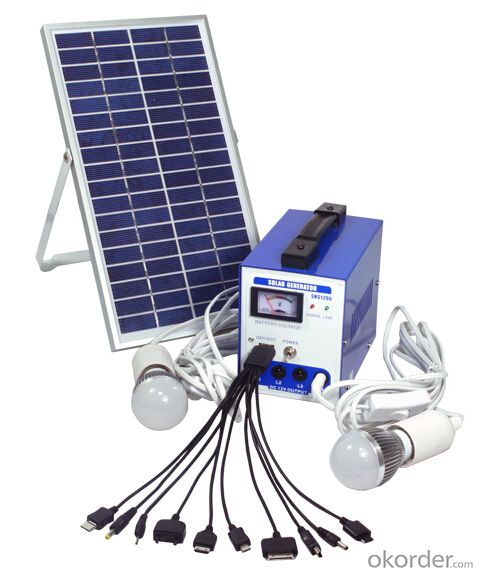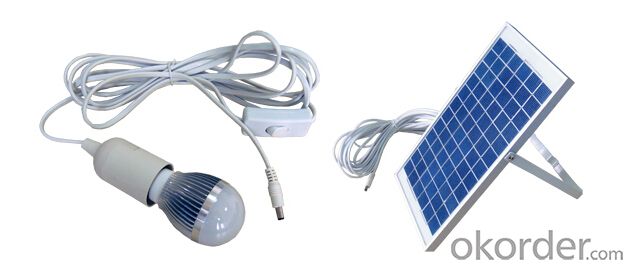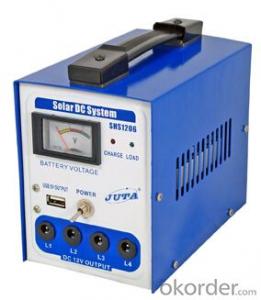4Ah/ 6W Solar Home System for Lighting Model SHS1206
- Loading Port:
- Shanghai
- Payment Terms:
- TT OR LC
- Min Order Qty:
- 5 set
- Supply Capability:
- 150 set/month
OKorder Service Pledge
OKorder Financial Service
You Might Also Like
1. Structure of 4Ah Solar Home System for lighting Model SHS1206
4Ah DC/6W Solar Home System is designed for the small family. All the power comes from solar energy, clean and friendly to environment.
This system is usually used for home lighting/house lighting: such as remote area, mountainous area, desert area, grassland area, village, country area, camping, outdoor activities, travelling for light at night. It will play an important role in daily life.4AH DC solar power system has following components:
1.Solar module: 12V/6W. With 8m cable and 2.1mm DC port,poly crystalline. (one set)
2.LED lights, 12V/3W, white color. With 4m cable and 2.1mm DC port. (two sets)
3.Battery box with controller built-in. (one set)
2. Main Features of Solar Home System for lighting Model SHS1206
· Smart shape
· Convenient to carry about
· Better integrality: all components are in the packaging, put into use immediately after open the packaging
· Easy to make the assembly
3. Solar Home System for lighting Model SHS1206 Specification
product name | rated charging current | rated working voltage | float charging voltage | low voltage disconnecting point | USB port current | working temperature | dimension |
4Ah DC solar home system | 1A | 12V | 14V | 10.5V | ≤500mA | -10℃~50℃ | 160mm×96mm×135mm |
model | rated discharge current | solar panel voltage | no load loss | low voltage reconnecting point | humidity requirement | storage temperature | |
SHS1206 | 2A | ≤25 | ≤8mA | 11.5V | ≤90%,no condensation | -15℃~40℃ |
4. Solar Home System for lighting Model SHS1206 Images


5. FAQ
We have organized several common questions for our clients, which may help you sincerely:
1) How to guarantee the quality of the products?
The company is approved by the ISO9000 quality management system with its strict product quality control. The products for exportation pass the inspection of relevant foreign nations (CE, ROHS), and get high evaluation of the customers.
2) How long can we receive the product after signing Sales Confirmation?
Generally speaking, if there is enough quantity of finished products which can meet the clients’ requirement, we can manage the delivery within three to five working days according to the instruction of the payment terms in the Sales Confirmation; if the products need some time to get ready, we will arrange thedelivery as soon as possible after the manufacture.
- Q:What is the impact of roof orientation on the performance of solar panels?
- The impact of roof orientation on the performance of solar panels is significant. The orientation of the roof determines the amount of sunlight that the panels receive throughout the day. Ideally, solar panels should be installed on roofs that face south in the northern hemisphere and north in the southern hemisphere for maximum exposure to sunlight. East and west-facing roofs can still generate electricity, but their output may be lower. Additionally, the tilt angle of the roof can also affect the performance of solar panels. By optimizing roof orientation and tilt, the efficiency and productivity of solar panels can be greatly enhanced.
- Q:Can solar panels be installed on vertical surfaces?
- Indeed, it is possible to install solar panels on vertical surfaces. While the most commonly used and efficient method involves mounting solar panels on rooftops or tilted surfaces that face the sun, there are also specialized solar panels specifically designed for vertical installations. These solar panels, known as vertical or facade solar panels, are typically lightweight and frameless in design, making them easy to mount on vertical surfaces such as walls or building facades. Vertical solar panels are an excellent solution for buildings with limited roof space or for those who wish to maximize energy production on all available surfaces. However, it is important to note that vertical installations may not be as efficient as traditional rooftop installations due to the reduced exposure to sunlight. The performance of vertical solar panels can also be affected by the angle and orientation of the surface, as well as potential shading from nearby structures or trees. Nonetheless, advancements in solar technology and design have made vertical installations more practical and efficient than ever before. By carefully considering factors such as surface tilt, orientation, and shading, solar panels can be successfully installed on vertical surfaces, thus harnessing clean and renewable energy.
- Q:Can solar energy systems be installed on parking lots or carports?
- Yes, solar energy systems can definitely be installed on parking lots or carports. These locations provide ample space and exposure to sunlight, making them ideal for generating solar power. By installing solar panels on these structures, parking lots and carports can not only provide shade for vehicles but also generate clean and renewable energy.
- Q:Can solar energy systems be installed in areas with high winds?
- Solar energy systems are indeed capable of being installed in areas that experience strong winds. The consideration of wind speeds during the installation of solar panels is vital to guarantee their durability and longevity. These panels are specifically engineered to endure various weather conditions, including gusty winds. By implementing robust mounting systems and utilizing suitable fasteners, their ability to resist wind damage can be further reinforced. Furthermore, certain manufacturers subject their solar panels to rigorous testing procedures to ensure they can withstand high wind speeds. It is highly advisable to seek the guidance of a professional installer who can evaluate the unique conditions of the location and develop a solar energy system that can effectively endure strong winds.
- Q:What are the advantages and disadvantages of small-scale solar power generation system?
- Solar power has no moving parts, is not easy to damage, simple maintenance, especially suitable for unattended use; solar power will not produce any waste, no pollution, noise pollution, no adverse effects on the environment, is the ideal clean energy; solar power system short construction period, convenient and flexible, and can according to the load or, add or reduce photovoltaic capacity, avoid waste.
- Q:Can solar energy systems be used in areas with high population density?
- Yes, solar energy systems can be used in areas with high population density. In fact, solar energy systems can be particularly beneficial in densely populated areas as they can be installed on rooftops, buildings, and other available spaces, making efficient use of limited land resources. Additionally, solar energy systems can help reduce reliance on traditional energy sources, decrease greenhouse gas emissions, and contribute to a cleaner and more sustainable environment for densely populated communities.
- Q:Can solar energy systems be used for powering recycling facilities?
- Yes, solar energy systems can be used to power recycling facilities. Solar panels can generate electricity from the sun's energy, which can then be used to power the various operations and machinery involved in recycling processes. This renewable energy source helps reduce carbon emissions and makes recycling facilities more sustainable and environmentally friendly.
- Q:How long do solar energy systems typically last?
- Solar energy systems typically last for about 25 to 30 years.
- Q:What are the key components of a solar energy system?
- The key components of a solar energy system include solar panels, an inverter, a mounting system, batteries (optional), and a monitoring system.
- Q:How do solar energy systems impact the reliability of the electrical grid?
- Solar energy systems can have both positive and negative impacts on the reliability of the electrical grid. On the positive side, solar energy systems can enhance the reliability of the grid by diversifying the sources of electricity generation. Traditional power plants heavily rely on fossil fuels, which are finite and prone to price volatility. By integrating solar energy systems into the grid, we can reduce the dependence on fossil fuels and increase the share of renewable energy sources, which are typically more stable and sustainable. Additionally, solar energy systems can improve grid reliability by decentralizing power generation. Traditional power plants are usually centralized, which means that a disruption at one facility can lead to widespread blackouts. In contrast, solar energy systems are typically distributed across various locations, which reduces the risk of a single point of failure and enhances the overall resilience of the grid. However, solar energy systems also pose certain challenges to grid reliability. One of the main concerns is the intermittent nature of solar power generation. Solar panels only produce electricity when exposed to sunlight, which means that their output can fluctuate throughout the day and is completely absent during nighttime. This intermittency can create challenges in matching the supply and demand of electricity in real-time, potentially destabilizing the grid. To address this issue, grid operators need to implement effective energy storage solutions, such as batteries, to store excess solar energy during peak production periods and release it during periods of low or no solar generation. Additionally, advanced forecasting and grid management technologies can help predict and balance the intermittent nature of solar energy, ensuring a reliable and stable electricity supply. In conclusion, while solar energy systems can enhance the reliability of the electrical grid by diversifying energy sources and decentralizing power generation, their intermittent nature poses challenges that need to be addressed through energy storage and efficient grid management techniques. Overall, with proper planning and integration, solar energy systems can contribute to a more reliable and sustainable electrical grid.
1. Manufacturer Overview |
|
|---|---|
| Location | |
| Year Established | |
| Annual Output Value | |
| Main Markets | |
| Company Certifications | |
2. Manufacturer Certificates |
|
|---|---|
| a) Certification Name | |
| Range | |
| Reference | |
| Validity Period | |
3. Manufacturer Capability |
|
|---|---|
| a)Trade Capacity | |
| Nearest Port | |
| Export Percentage | |
| No.of Employees in Trade Department | |
| Language Spoken: | |
| b)Factory Information | |
| Factory Size: | |
| No. of Production Lines | |
| Contract Manufacturing | |
| Product Price Range | |
Send your message to us
4Ah/ 6W Solar Home System for Lighting Model SHS1206
- Loading Port:
- Shanghai
- Payment Terms:
- TT OR LC
- Min Order Qty:
- 5 set
- Supply Capability:
- 150 set/month
OKorder Service Pledge
OKorder Financial Service
Similar products
New products
Hot products
Related keywords




























